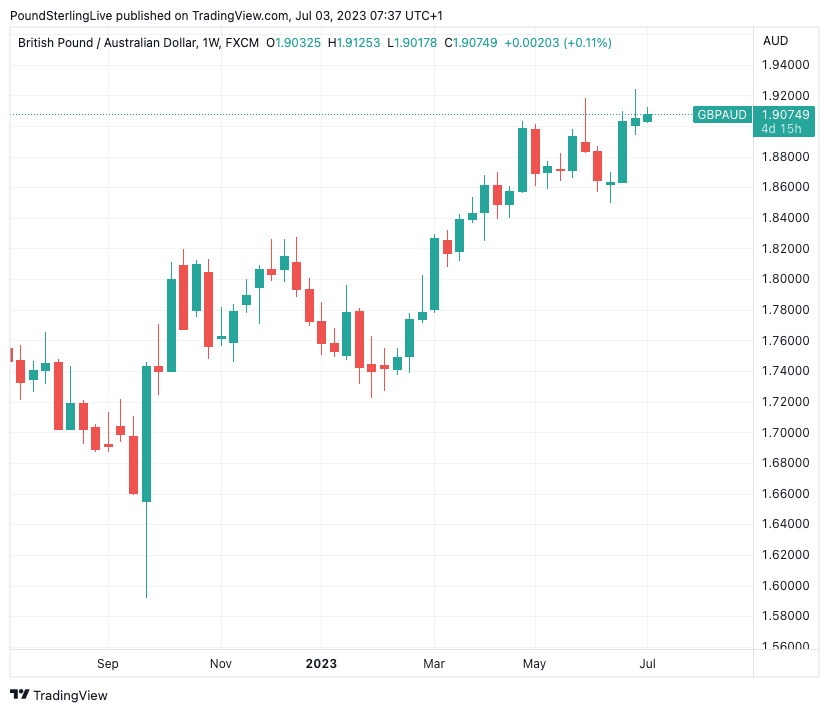GBP/AUD Rate Week Ahead Forecast: Retest of Highs if Skittish RBA Avoids a Rate Hike
- Written by: Gary Howes
-
- GBPAUD in a convincing medium-term uptrend
- RBA rate hike could delay a retest of three-year highs
- But 50/50 odds of another hike point to uncertain thinking at RBA
- Aussie housing data comes in above expectation on Monday

Image © ArchivesACT, Reproduced under CC Licensing, Editorial, Non-Commercial
This week, the Australian Dollar's main focus will be Tuesday's interest rate decision at the Reserve Bank of Australia (RBA), which could result in another test of three-year lows against the Pound, or another short-term comeback.
The market is split 50/50 on whether or not the RBA will hike again which means even odds on calling whether or not the Australian Dollar will rally or slide. A Bloomberg survey found 14 institutional economists forecast no change and 13 looking for another 25 basis point hike to 4.35%.
"Such pricing warns of a volatile ride for the Aussie," says Sean Callow, a strategist at Westpac.
To be sure, this is a highly unpredictable central bank that has already halted its rate hiking cycle, only to restart it again in June.
This skittish approach to interest rate management reflects an uncertainty at the Bank regarding the outlook for Australian inflation and a clear bias against 'over hiking' for fear of hurting the economy.
In this vein the RBA stands as one of the most politically-vulnerable central banks in the G10, frequently coming in for direct criticism from Australian politicians and the media during this hiking cycle.
"We expect the RBA to hike the cash rate by 25bp next week. In the last two policy meetings, the RBA maintained a hawkish tilt in its consideration for monetary policy," says Antony George, a foreign exchange analyst at NatWest Markets.
The arguments for another rate hike will have been bolstered Monday with the release of domestic data showing building approvals rocketed 20.6% month-on-month in May, surpassing economist expectations for a reading of 2.0% and more than reversing the -6.8% of April.
Home loans were meanwhile higher by 4.8% month-on-month as a -3.0% for the previous month was reversed. This follows CoreLogic dwelling prices data which showed prices rose for a fourth consecutive month in June, increasing 1.2% across the combined capital cities.
The labour market also remains robust, supported by strong immigration, which means unemployment will remain low and keep pressure on wages.
But the Pound to Australian Dollar exchange rate (GBPAUD) rallied to a new three-year high last week at 1.9239 as investors lowered expectations for a July interest rate hike after the release of official data that confirmed inflation in Australia is decelerating.
Above: GBPAUD at weekly intervals.
Interest rate expectations were pared after the ABS reported its monthly CPI indicator rose 5.6% in the twelve months to May, a shortfall on the 6.1% figure the market was expecting and the 6.8% reported the previous month.
"The Australian dollar struggled last week against a firm greenback and as Australia’s May CPI cooled expectations for RBA tightening," says Callow.
Where does the RBA place emphasis, on the falling inflation or on signs of resilience in the domestic housing market and fears inflation risks being temporarily elevated?
"We don't think the RBA will be swayed to pause by last month’s inflation result," says Gregorius Steven, an economist at ANZ. "Strength from the employment data should outweigh any optimism on inflation."
But given the last two decisions were described by the Board as "finely balanced", Steven concedes there is a chance the monthly CPI data could shift the RBA to pause in July.
"This would change the timing and not the peak in our forecast of 4.6%," he adds.
Should the RBA proceed with a rate hike there is a chance the Pound-Australian Dollar rate remains capped below the three-year high at 1.9239 for some time longer, although the strength of the uptrend suggests it is a matter of time before a retest of this level occurs.
The Pound has trended higher against the Australian Dollar for over half a year now and weakness has ultimately proven to be consistent with short-term pullbacks that ultimately yield to the broader trend.
It is too soon to call the end of the trend at this juncture as we would need a clearer breakdown in technical indicators to confirm the uptrend has stalled and is at risk of reversal.
Should the RBA forgo an interest rate hike the prospect of the uptrend restarting sooner becomes heightened.






